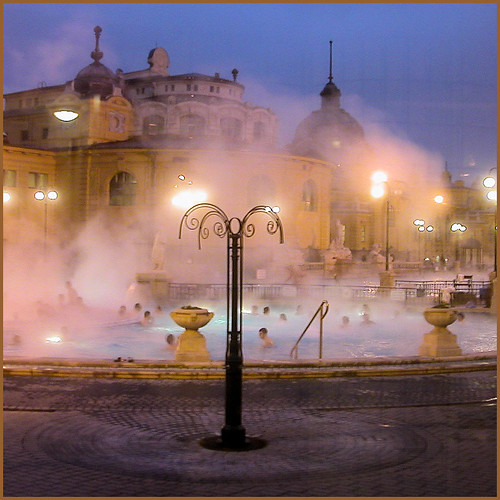Hungary: Sumptuously Steeped in Spa culture
Budapest is one of the world’s prettiest capitals.

Its broad boulevards are lined by leafy trees shading sidewalk cafes and lovely Art Nouveau/Secessionist buildings. The Baroque Buda Castle and neo-Gothic Hungarian Parliament buildings—especially striking when lit up at night—dazzle from opposite sides of the Danube River. And monumental statues around the city tell the story of the ebb and flow Hungary’s history, revealing connections with the Romans, Hapsburgs, Ottomans and other powers and hinting at a time when its boundaries defined an area triple its current size.
Yet what really sets Budapest—and Hungary—apart is the spa culture that has evolved around its naturally-heated thermal waters. Even before the ancient Romans came to partake of its healthful benefits, people were drinking and soaking in Hungary’s mineral-rich waters. All told, the country has more than 1,500 known mineral-rich hot springs; many are the focus of historic, elegant spas and spa towns, and soaking in these heated pools is an integral part of wellness in Hungary.
Every thermal bath has different characteristics; the ills they are used for include degenerative joint and spine diseases, chronic arthritis, orthopedic and post-traumatic rehabilitation, spinal conditions, neuralgia, and bone calcium deficiencies. In addition, the water in the drinking halls are used to treat digestive and other problems.
In Budapest alone, there are more than 120 active spas. The expansive Széchenyi Thermal Baths, the largest in Europe, is the most popular. It offers 18 medicinal water pools, plus saunas, aqua-fitness and steam chambers along with massages and beer baths, said to do wonders for the skin.
Adding to the fun is an outdoor adventure pool, hot tub, and swimming and drift pools. Plus, February to December, weekend evenings are party nights, with electronic music and spectacular lights.
Located in the heart of City Park, the spa is steps from Heroes’ Square, Vajdahunyad Castle, and the new House of Music Hungary, which celebrates Hungarian composers including Ferenc Liszt, Béla Bartók, Zoltán Kodály, György Ligeti and Zoltán Kocsis.
Elegant and exclusive, Gellért Bath is the city’s most famous. Housed in an Art Nouveau building and hotel that opened in 1911, it is an official national monument. With sculptures and stained glass windows by famous artists of the time, walls tiled with ceramics by the acclaimed Zsolnay factory, and exquisite frescoed ceilings, stone columns, and domed ceilings, Gellert makes you feel like you’re bathing in a palace or a museum. No wonder it has drawn a roster of famous patrons including Queen Juliana of the Netherlands, Andrew Lloyd Webber, Uma Thurman and Ryan Goslin.
Located at the foot of Gellért Hill, the spa overlooks the Danube River. In addition to therapeutic indoor pools, there’s a swimming pool, an outdoor wave pool in summer (the world’s first), an outdoor thermal pool and rooms for private bathing. There are also saunas and steam rooms and a variety of massage therapies, including couples massages and a red wine bath, said to rejuvenate the skin.
Another favorite, Rudas Thermal Bath is one of Budapest’s many Turkish baths built dating back to the Ottoman occupation. Centered around a 16th century central octagon-shaped pool capped by a high domed ceiling, Rudas feels like a Turkish hammam. It is also one of the city’s few spas to have men-only and women-only hours.
Rudas offers a full range a spa services and its own terrace bistro. For many, the best time to come is on a Friday or Saturday night when the baths stay open from 10 p.m. to 3 a.m. and the modern rooftop pool affords glamorous views of city lights reflecting in the Danube.
Rural bath destinations beckon throughout Hungary. The most famous is the spa town of Hévíz, whose name actually means warm water. Located near the western tip of Lake Balaton, Hévíz is the world’s largest biologically active thermal water lake. It is fed by hot and cold springs so its temperature stays within a range that allows swimming year-round. Here, spa-goers can soak in thermal baths and relax in saunas, steam baths, salt caves and a light-room. Special offerings include mud packs and beauty treatments using the salutary lake mud, massage, physiotherapy and hydrotherapy.
Lake Balaton, Central Europe’s largest lake, is about two hours from Budapest by car; 2 hours 40 minutes by train. It is a great destination for nature and active outdoor pursuits and wine-tastings.
Throughout Hungary, healing waters and cocooning settings help guests unwind and be immersed in a spa culture that goes back to ancient times.
For more information visit: HYPERLINK “http://www.hungary.com/”www.visithungary.com




